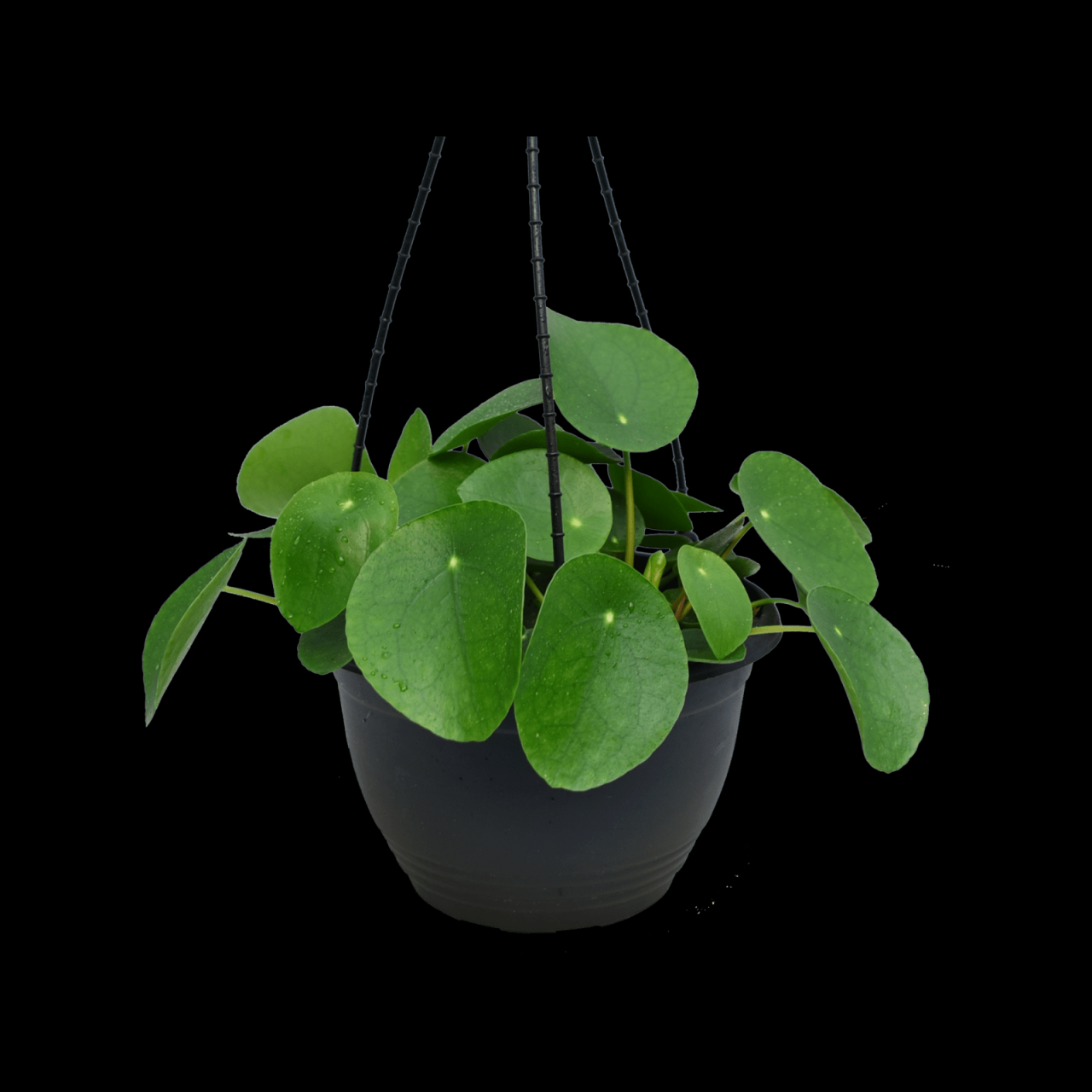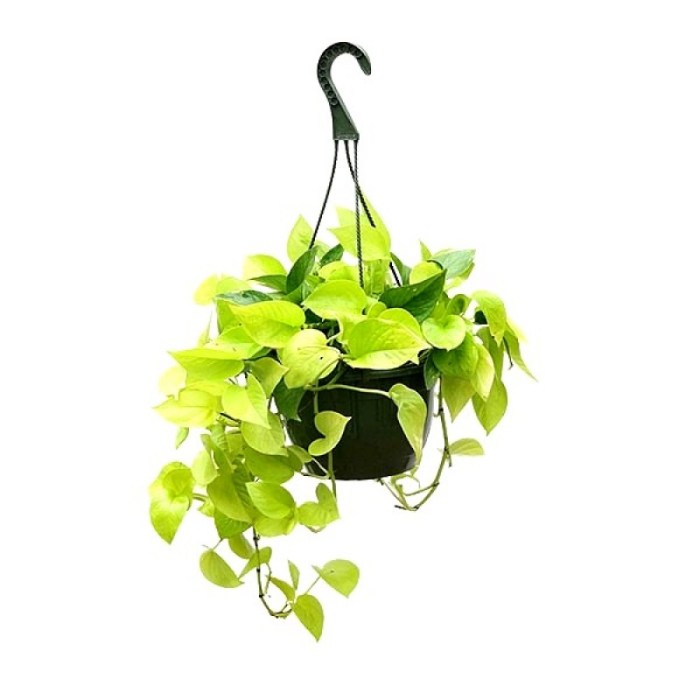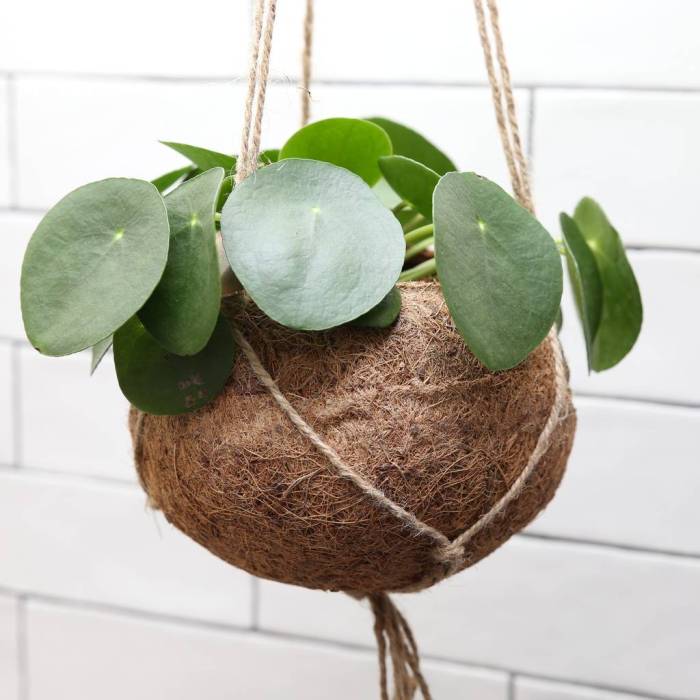Discover the enchanting world of Chinese money plant hanging baskets, where ancient feng shui beliefs intertwine with modern interior design trends. This guide delves into the intricate care, captivating benefits, and diverse varieties of this captivating plant, providing you with the knowledge to cultivate a thriving and aesthetically pleasing addition to your home.
From its optimal lighting conditions to its traditional uses in Chinese culture, this comprehensive exploration unravels the secrets of the Chinese money plant, empowering you to nurture its vibrant growth and harness its positive energy.
Plant Care and Maintenance

To ensure the health and longevity of your Chinese money plant hanging basket, it is essential to provide it with proper care and maintenance. This includes providing optimal lighting conditions, regular watering and fertilizing, and timely pruning and repotting.
Light Conditions
Chinese money plants thrive in bright, indirect light. Direct sunlight can scorch the leaves, while insufficient light can lead to leggy growth and fewer leaves. An ideal location for a hanging basket is near a north-facing window or in a room with ample natural light but no direct sunlight.
Watering and Fertilizing
Water your Chinese money plant when the top inch of soil feels dry to the touch. Avoid overwatering, as this can lead to root rot. Use lukewarm water and allow the excess to drain out of the drainage holes. Fertilize the plant monthly during the growing season with a balanced liquid fertilizer diluted to half strength.
Pruning and Repotting
Prune your Chinese money plant as needed to remove dead or damaged leaves and stems. You can also prune the plant to control its size or shape. Repot the plant every two to three years, or when the roots become pot-bound.
Use a well-draining potting mix and a pot that is slightly larger than the previous one.
Benefits and Uses: Chinese Money Plant Hanging Basket

The Chinese money plant is not only known for its aesthetic appeal but also for its purported feng shui benefits and traditional uses. In Chinese culture, it is believed to bring prosperity, wealth, and good fortune. The round, coin-shaped leaves symbolize coins, making it a popular choice for businesses and homes alike.
The Chinese money plant hanging basket is an excellent choice for adding greenery to any room, including the kitchen. As one of the best hanging plants for the kitchen , it thrives in humid environments and can tolerate lower light levels.
Its trailing vines and round, coin-shaped leaves create a lush and inviting atmosphere, making it a perfect addition to any kitchen decor.
Feng Shui Benefits
According to feng shui principles, the Chinese money plant is associated with the element of wood, representing growth, prosperity, and abundance. It is believed to enhance the flow of positive energy, known as chi, throughout a space. Placing the plant in the southeast corner of a room, which is associated with wealth and abundance, is said to maximize its benefits.
Interior Design
The Chinese money plant’s unique foliage and trailing stems make it a versatile choice for interior design. It can be used to create lush hanging baskets, cascading down from shelves or windowsills. Its glossy leaves add a touch of greenery and vitality to any space, making it a popular choice for both homes and offices.
Traditional Uses
In Chinese culture, the Chinese money plant has been traditionally used for medicinal purposes. Its leaves are believed to have anti-inflammatory and antimicrobial properties and have been used to treat a variety of ailments. The plant is also used in traditional Chinese cuisine, where its leaves are added to soups and salads.
If you’re looking for a stylish and low-maintenance way to add some greenery to your home, a Chinese money plant hanging basket is a great option. These plants are known for their easy care and ability to thrive in a variety of lighting conditions.
They’re also a popular choice for Bunnings indoor hanging plants because they can add a touch of elegance to any room. With their cascading vines and lush foliage, Chinese money plants are sure to make a statement in your home.
Varieties and Characteristics

The Chinese money plant, also known as Pilea peperomioides, comes in a range of varieties, each with its unique characteristics. These varieties differ in growth habit, leaf shape, and size.
One of the most common varieties is the ‘Original’, which is known for its large, round leaves with a deep green color. The ‘Suzette’ variety, on the other hand, has smaller, oval-shaped leaves with a variegated pattern. The ‘Mini’ variety is a dwarf form with tiny leaves, making it ideal for small spaces.
If you’re looking for a lush and easy-to-care-for hanging plant, a Chinese money plant hanging basket is a great choice. Its trailing vines and round, coin-shaped leaves add a touch of elegance to any space. For those who prefer to shop online, buying trailing plants online is a convenient option.
You can find a wide variety of Chinese money plants and other trailing plants to suit your needs and style.
Growth Habit
- The Chinese money plant typically grows in a bushy, upright form.
- It can reach heights of up to 12 inches and widths of up to 18 inches.
- The plant produces long, trailing stems that can be trained to climb or cascade over a support.
Leaf Shape and Size
- The Chinese money plant has round or oval-shaped leaves.
- The leaves are typically 2-4 inches in diameter.
- The leaves have a glossy surface and a slightly cupped shape.
| Variety | Growth Habit | Leaf Shape | Leaf Size |
|---|---|---|---|
| Original | Bushy, upright | Round | 2-4 inches |
| Suzette | Bushy, upright | Oval | 2-3 inches |
| Mini | Dwarf | Round | 1-2 inches |
Propagation and Growth

Propagating a Chinese money plant from cuttings is a simple process that can be done at home. To start, select a healthy stem with several leaves and cut it below a node. Remove the bottom leaves from the stem, leaving only the top few.
Dip the end of the stem in rooting hormone and plant it in a pot filled with well-draining potting mix. Keep the soil moist and place the pot in a warm, humid location. The cutting should root within a few weeks.Once
the cutting has rooted, it can be transplanted into a larger pot. Choose a pot with drainage holes and fill it with fresh potting mix. Gently remove the cutting from the old pot and loosen the roots. Plant the cutting in the new pot, making sure that the roots are covered with soil.
Water the plant thoroughly and place it in a bright, indirect light location.Chinese money plants grow best in warm, humid environments. The ideal temperature for growth is between 65 and 85 degrees Fahrenheit (18 and 29 degrees Celsius). The plant should be watered regularly, but avoid overwatering.
Allow the soil to dry out slightly between waterings.
Troubleshooting Common Issues

Chinese money plants in hanging baskets are generally easy to care for, but they can still be susceptible to certain problems. Identifying and addressing these issues promptly can help keep your plant healthy and thriving.
Yellowing Leaves
- Overwatering:Excessive watering can lead to root rot, which causes leaves to turn yellow and fall off. Allow the soil to dry out completely between waterings.
- Underwatering:Insufficient watering can also cause leaves to yellow. Water your plant thoroughly when the soil is dry to the touch.
- Nutrient deficiency:Yellowing leaves can be a sign of nutrient deficiency, particularly nitrogen or iron. Fertilize your plant regularly with a balanced fertilizer.
Root Rot, Chinese money plant hanging basket
- Overwatering:Root rot is caused by excessive watering, which leads to waterlogged soil and oxygen deprivation. Avoid overwatering and allow the soil to drain well.
- Poor drainage:If the hanging basket does not have adequate drainage holes, excess water can accumulate at the bottom, leading to root rot. Ensure proper drainage by making sure the basket has multiple drainage holes.
Pests
- Aphids:These small, green or black insects can suck the sap from leaves, causing them to yellow and curl. Treat aphids with insecticidal soap or neem oil.
- Mealybugs:These small, white, cottony insects can feed on the stems and leaves of the plant. Treat mealybugs with rubbing alcohol or horticultural oil.
- Spider mites:These tiny, spider-like pests can cause leaves to turn yellow and develop fine webbing. Treat spider mites with insecticidal soap or neem oil.
Final Review
Whether you seek to enhance your living space with a touch of nature, attract prosperity according to feng shui principles, or simply admire the beauty of this unique plant, the Chinese money plant hanging basket offers an enchanting fusion of practicality and aesthetics.
Embrace its versatility and enjoy the benefits it brings to your home and well-being.
Essential Questionnaire
How often should I water a Chinese money plant in a hanging basket?
Water the plant thoroughly when the soil feels dry to the touch, approximately once a week during the growing season and less frequently during the winter months.
What are the benefits of having a Chinese money plant in my home according to feng shui?
In feng shui, the Chinese money plant is believed to attract prosperity and abundance. Placing it in the southeast corner of your home is said to enhance wealth and financial luck.
How can I propagate a Chinese money plant from cuttings?
Take a stem cutting with at least two leaves and place it in a glass of water. Keep the cutting in a bright location and change the water regularly until roots develop, then transplant it into a pot with well-draining soil.